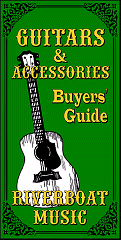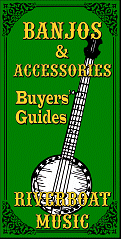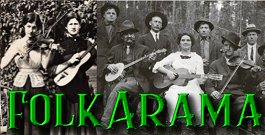
PART 1 - The D Chord
| Please Read: How to Help Our Site at No Cost to You - Some of our articles contain recommendations for products we like and vendors we personally trust. Some of those vendors may pay us a very small commission if you click on a link and buy their products. This costs you nothing at all and helps offset the costs of what we do. So if we point you to something you decide to buy later, please make certain you come back through our site and click on the link directly. Thanks. |
| This Site is a Cookie-Free Zone - Except for discussion forums that you have to expressly register for, none of our pages use cookies of any kind. Some of the vendors we link to do, but that won't affect you unless you click on a link to their pages. Your continued use of this page indicates that you agree to our policy. For details, click here. |



|


3 Magic Cords
This is part of the "VERY Basic Guitar subset of our "How To Folk" articles. In an effort to "jump start" your enjoyment of Folk music and your ability to join in, no matter what instrument you play, we are providing some very basic notes about guitar chords.

 Note: - This part of the Folkarama page, which is dedicated to helping beginners "get into" Folk music and join Folk communities as easily as possible, with simple articles and links to resources that provide hands-on instruction in traditional acoustic instruments.
Note: - This part of the Folkarama page, which is dedicated to helping beginners "get into" Folk music and join Folk communities as easily as possible, with simple articles and links to resources that provide hands-on instruction in traditional acoustic instruments.
Folkarama, in turn, contains many references to more extensive articles and resources in Paul Race's CreekDontRise.com site, as well as other related pages.
 Skipping Ahead?
Skipping Ahead?
If you already have some exposure to guitar, and know what the little squares to the right signify, I'll let you know that this series covers D, A7, and G as a way of introducing you to the world of 3-chord songs. The next section is targeted to people who are new to guitar, so you may skim them if you want.
The D Chord (and "What's Up With Those Little Squares?")
The "Key" of a song usually indicates what scale the song is using and - more often than not - what note and chord the song will end on. Many acoustic guitar players like to pitch songs in the key of D, because the D chord and the other chords you're likely to use in the key of D are some of the easiest to learn on guitar.Not only that, but you can play literally thousands of Folk songs, as well as songs in other genres, with just the D chord and two other chords.
 The most common D chord is shown to the right in a format used in countless music books. If it looks strange to you, don't worry. The format is explained in the text below and the next picture down.
The most common D chord is shown to the right in a format used in countless music books. If it looks strange to you, don't worry. The format is explained in the text below and the next picture down.
The horizontal black line at the top represents the guitar' "nut," the slotted piece of bone or plastic that the strings pass over as they leave tuning head and start to hover over the fingerboard.
The vertical bars represent the strings, with the bar to the left representing the string closest to you. They are actually numbered from right to left, which confuses a lot of people, but I'm not in a position to change that. So the string closest to you, shown at the left in the little chart, is actually string number six.
The other horizontal bars represent the frets, those metal rails that run perpendicular to the guitar neck and let you play higher or lower notes on the strings. You put your fingers just behind them, to force the strings down on them. Most people take a while to build up callouses so it doesn't hurt. If the guitar has "bad action," it's especially hard to do, so it's a good idea to have someone check your guitar out before you start and make certain it won't discourage you more than necessary.
Don't feel bad if you can only play for a few minutes at a time at first. But keep it up, or you'll never get past that most basic hurdle.
The next picture shows labels for all of the things we described in the paragraphs above. 
The Ubiquitous Triangle - The shape of the D chord is almost unique on a guitar, so it's easy to spot. there are other ways to play a D chord, plus variations that change the shape, but just recognizing this triangle on sight is one way to get a sense of what chords are being played or likely to be played. There's a reason why you see experienced guitarists staring at each others' left hand when they're playing a unfamiliar song.
In this sort of chord chart, the little circles represent places where you put your fingers to play the chord. In large chord charts like this one, the numbers represent which finger you use to play each string.
So your "middle" or "index" finger (#2) goes just behind the second fret on the first string.
Your ring finger (#3) goes just behind the third fret on the second string.
Your "pointer" finger (#1) goes just behind the second fret on the third string.
The 0s at the top of the chord chart indicate that the strings aren't fretted, but they ARE played.
The X at the top of the first string indicates that the string isn't fretted OR played.
Songs You Can Play With Only the D Chord - "Farmer in the Dell," "Frere Jaques," and "Row, Row, Row Your Boat."
 Strumming - For now, we're going to start with a very basic strum. If you have a flat pick, hold it between your thumb and forefinger so that the pointiest part sticks out about between 1/8" and 1/4".
Strumming - For now, we're going to start with a very basic strum. If you have a flat pick, hold it between your thumb and forefinger so that the pointiest part sticks out about between 1/8" and 1/4".
For the D chord, avoid hitting the lowest string. The "best practice" is to start with the fourth (D) string and strum downward as shown in the picture to the right.
If you happen to hit the fifth (A) string, nobody would likely notice. But please avoid hitting the lowest (E) string, as that note is not in the chord.
Practicing - The first few days of playing guitar, you'll notice your fingers getting sore quickly. Consider practicing twenty minutes at a time and taking a break. At least until your fingers stop hurting. Maybe play all the songs I listed above through a couple times, and tnen chill for a bit. If you can do 2 or 3 twenty minute sessions the first few days, that's good. Don't take a day off if you can possibly avoid it.
Your fingers will eventually build up callouses that allow you to play longer each time, until you're up to an hour or more without serious pain. So, like any other form of exercise, you have to keep going back in. I need to keep playing to keep my callouses, and I've been playing guitar for over fifty years.
The reward of coaxing music from a hunk of wood and wires is worth it.
But if at any time it looks like you might be forming a blister, stop at once. A blister will pretty much undo the callous on that finger, and you'll basically have to start over.
Breaking Things Up - If you get through what I've written about the D chord, and feel like you need to take a break, fine. Tomorrow, re-reading the section above and see if it's starting to sink in. And play those songs over and over. When you get bored enough and your fingers get strong enough, go on to the A7 section.
Whether it takes you a day or a week to get through each new chord section, the important thing is that you stay with it. I don't know your age, but at my age, I can learn a whole lot about a music instrument in a very short period of time, but if I put it on the shelf for a week and then come back, I pretty much have to start over. Consistency is key.
When you need to move on, go to Part 2 - A7, the D Chord's BFF.
Conclusion
These suggestions are just a start, of course. But for all of its variations and even contradictions, Folk music is a discipline in itself, and a rewarding one of that. The more you play, sing, practice, and hang, the more you'll get out of it, the faster you'll learn in the future, and the better you'll be at whatever you already do have "under your belt."Other Resources
There are plenty of guitar instruction materials, online, of course. But we are working on a few that will help you learn the most basic, but necessary, information quickly.The current resources we have published are:
- Meet Your Guitar - a very basic intro to holding, tuning, and picking the guitar.
- Three Magic Chords - a three-part series to introduce enough easy guitar chords to get you started on playing hundreds of 2- and 3-chord songs. Articles include::
- 3-Chord Songs in D - A list of songs you can easily play in D, using G and A7. (When you get a little farther along, you can also play many of them in E, using E, A, and B7. Or in C, using C, F, and G7. Yes, we will show you all of those chords eventually.)
- What is a Three-Chorder? - Explains "3-chorders," and how understanding them will help you learn or follow along on thousands of songs without sheet music or lead sheets.
- More Useful Chords - "Next steps" to expand your range and enable you to play even more songs, including:
- C and C9 Chords
- It's All Relative - Am and Em
- A Major - the Fiddler's Friend
- E Major, a Cornerstone of Blues and Folk
- F Major - Set your C Chord Free!
- 3-Chord Songs in G - A list of songs you can easily play in G using G, C9 (or C) and D7. (When you get a little farther along, you can also play many of them in A, using A, E7 and D.)
- About Capos - A necessary tool that can become a crutch if you rely on it too much.
Sister Sites
 Other sites we started to keep this site from getting too big to be useful include:
Other sites we started to keep this site from getting too big to be useful include:
- CreekDontRise.com is a repository of articles about Folk music and the instruments on which it has been traditionally played.
The "Acoustic" page includes a long list of articles including maintenance and playing tips on all sorts of traditional acoustic instruments.
 RiverboatMusic.com is a buyers' guide for acoustic and traditional instrument from a musician's point of view, focusing on the uses, reliability, and practicality of various instruments, and not just the marketing hype about the shape of the fret markers or whatever.
RiverboatMusic.com is a buyers' guide for acoustic and traditional instrument from a musician's point of view, focusing on the uses, reliability, and practicality of various instruments, and not just the marketing hype about the shape of the fret markers or whatever.
For instruments like dulcimers that have mostly small manufacturers or cheap imports, we try to tell you what to look for, irrespective of brand.
 Momma Don't 'Low includes a free e-mail newsletter that discusses all of those topics above and more. We plan to include other features as time permits.
Momma Don't 'Low includes a free e-mail newsletter that discusses all of those topics above and more. We plan to include other features as time permits.
Note - If you wish to sign up for our newsletter and ask a question at the same time, please click on the Momma Don't 'Low newsletter button to learn more and to get a link to our signup form.
 PaulRaceMusic.com is the "landing page" for Paul's own musical endeavors, plus many memoirs and blogs about music and the music business.
PaulRaceMusic.com is the "landing page" for Paul's own musical endeavors, plus many memoirs and blogs about music and the music business.
 ClassicTrainSongs.com describes railroad songs that every train lover should know. Or at least know about.
ClassicTrainSongs.com describes railroad songs that every train lover should know. Or at least know about.
- SchoolOfTheRock.com has articles about Christian music, Christian music careers and performance, Christian living in general, and vintage saxophones, another of Paul's interests. This site has separate newsletters, etc., by the way - there isn't a lot of overlap with the Momma Don't 'Low(tm) newsletters.
For information about other music collections and projects, check the links at the bottom of this page.
 Whatever else you get out of our pages, I hope you come away with some great ideas for "sharing the joy."
Whatever else you get out of our pages, I hope you come away with some great ideas for "sharing the joy."
And please stay in touch!
All material, illustrations, and content of this web site is copyrighted (c) 2001, 2002, 2003, 2004, 2005, 2006,
2007, 2008, 2009, 2010, 2011, 2012, 2013, 2014, 2015, 2016, 2017, 2018, 2019, 2020, 2021, 2022, 2023 by Paul D. Race. All rights reserved.
Creek Dont' RiseTM is a participant in the Amazon Services LLC Associates Program, an affiliate advertising
program designed to provide a means for sites to earn advertising fees by advertising and linking to Amazon.com.
For questions, comments, suggestions, trouble reports, etc. about this page or this site, please contact us.
| Visit related pages and affiliated sites: | |||||
| - Music - | |||||

|
 |
 |

|

|

|

|

|

|

|

|

|

|

|

|

|

|

|
| - Trains and Hobbies - | |||||
 |

|

|  |
 |

|
| - Christmas Memories and Collectibles - | |||||
 |

|
 |

|
 |

|
| - Family Activities and Crafts - | |||||
 |

|

|

|

|

|

